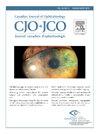原发性后天性鼻泪管阻塞患者鼻泪管和鼻窦解剖结构变化的形态计量分析。
IF 3.3
4区 医学
Q1 OPHTHALMOLOGY
Canadian journal of ophthalmology. Journal canadien d'ophtalmologie
Pub Date : 2025-02-01
DOI:10.1016/j.jcjo.2024.05.028
引用次数: 0
摘要
研究目的本研究旨在通过计算机断层扫描(CT)评估单侧原发性获得性鼻泪管阻塞(PANDO)亚洲患者的骨性鼻泪管(BNLD)和鼻窦解剖结构的形态变化:我们招募了 34 名接受了内窥镜泪囊鼻腔造口术的单侧原发性鼻泪管阻塞(PANDO)患者,以及 34 名年龄和性别相匹配、无外咽主诉记录的对照组患者。我们比较了 PANDO 患者和对照组患侧和非患侧 CT 图像上的 BNLD 和鼻窦参数:单侧 PANDO 患者患侧的 BNLD 入口面积大于未患侧(p = 0.012)和对照组(p = 0.046)。与对照组相比,患侧(p = 0.044)和未患侧(p = 0.028)在冠状面上的开角更大。三组的最小面积和远端面积在轴向平面上没有差异。研究组和对照组的副鼻腔参数没有差异。与对照组相比,研究组有更多患者的鼻中隔偏曲位于上部(P = 0.048)。有趋势表明,与对照组相比,研究组中有更多患者的鼻中隔偏曲位于前方(p = 0.056),但未达到统计学意义:结论:从流体学角度看,PANDO 患者的角度倾斜增加可能会阻碍液体引流。患侧较大的 BNLD 面积反映了炎症引起的骨溶解。此外,鼻窦变异,尤其是鼻中隔前半部和上半部偏曲,也被认为是导致 PANDO 风险升高的原因。本文章由计算机程序翻译,如有差异,请以英文原文为准。
Morphometric analysis of bony nasolacrimal canal and sinonasal anatomical variations in primary acquired nasolacrimal duct obstruction
Objective
This study aims to assess morphometric variations in bony nasolacrimal ducts (BNLDs) and sinonasal anatomy in Asian patients with unilateral primary acquired nasolacrimal duct obstruction (PANDO) through computed tomography (CT).
Methods
We enrolled 34 patients with unilateral PANDO who underwent endoscopic dacryocystorhinostomy, alongside 34 age- and sex-matched control patients without documented epiphora complaints. We compared BNLD and sinonasal parameters on CT images between the affected and unaffected sides of PANDO patients and the control group.
Results
The entrance area of the BNLD was larger on the affected side of unilateral PANDO patients compared to both the unaffected side (p = 0.012) and the control group (p = 0.046). The open angle in the coronal plane was greater on both the affected (p = 0.044) and unaffected side (p = 0.028) than in the control group. Minimal area and distal area in the axial plane showed no differences among the 3 groups. Paranasal parameters did not differ between the study and control groups. More patients in the study group had superiorly located nasal septum deviation than the control group (p = 0.048). A trend suggested that more patients in the study group had anteriorly located nasal septum deviation than the control group (p = 0.056), although not reaching statistical significance.
Conclusion
The increased angular tilt in PANDO patients could impede fluid drainage from a fluidics standpoint. The larger BNLD area on the affected side reflects inflammation-induced osteolysis. Additionally, sinonasal variations, particularly nasal septum deviation at the anterior and superior half, have been identified as contributing to a higher risk of PANDO.
Objectif
Notre étude a eu recours à la tomographie assistée par ordinateur pour évaluer les variations morphométriques du canal nasolacrymal osseux (CNLO) et de l'anatomie nasosinusienne chez des patients asiatiques présentant une sténose acquise non spécifique du canal lacrymonasal (PANDO, pour primary acquired nasolacrimal duct obstruction) unilatérale.
Méthodes
Nous avons recruté 34 patients atteints d'une PANDO unilatérale qui ont subi une dacryocystorhinostomie endoscopique ainsi que 34 sujets témoins sans larmoiement avéré et appariés pour l’âge et le sexe. Nous avons comparé le CNLO et les paramètres nasosinusiens sur les images tomographiques des patients du groupe PANDO (côtés atteints et normaux) et ceux du groupe témoin.
Résultats
Chez les patients qui présentaient une PANDO unilatérale, l'entrée du CNLO était plus évasée du côté atteint, comparativement à celle du côté normal (p = 0,012) et à celle des patients du groupe témoin (p = 0,046). L'angle ouvert du plan frontal était plus grand, tant du côté atteint (p = 0,044) que du côté normal (p = 0,028), comparativement à celui du groupe témoin. On n'a enregistré aucune différence entre les 3 groupes quant à l'aire minimale et à l'aire distale dans le plan axial. Les paramètres paranasaux ne différaient pas entre le groupe à l’étude et le groupe témoin. La déviation septale avait une localisation supérieure chez un plus grand nombre de patients du groupe à l’étude que du groupe témoin (p = 0,048). La déviation septale tendait à avoir une localisation antérieure chez un plus grand nombre de patients du groupe à l’étude que du groupe témoin (p = 0,056), mais cette tendance n'était pas significative sur le plan statistique.
Conclusion
L'accroissement de l'inclinaison angulaire chez les patients présentant une PANDO pourrait nuire à l’écoulement du point de vue de la fluidique. L'aire plus importante du CNLO du côté atteint est le reflet de l'ostéolyse secondaire à l'inflammation. Qui plus est, les altérations nasosinusiennes, surtout la déviation septale dans la partie antérosupérieure, sont reconnues pour accroître le risque de PANDO.
求助全文
通过发布文献求助,成功后即可免费获取论文全文。
去求助
来源期刊
CiteScore
3.20
自引率
4.80%
发文量
223
审稿时长
38 days
期刊介绍:
Official journal of the Canadian Ophthalmological Society.
The Canadian Journal of Ophthalmology (CJO) is the official journal of the Canadian Ophthalmological Society and is committed to timely publication of original, peer-reviewed ophthalmology and vision science articles.

 求助内容:
求助内容: 应助结果提醒方式:
应助结果提醒方式:


